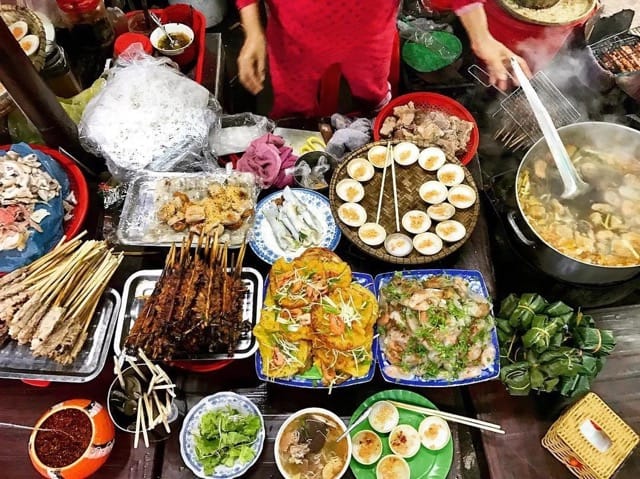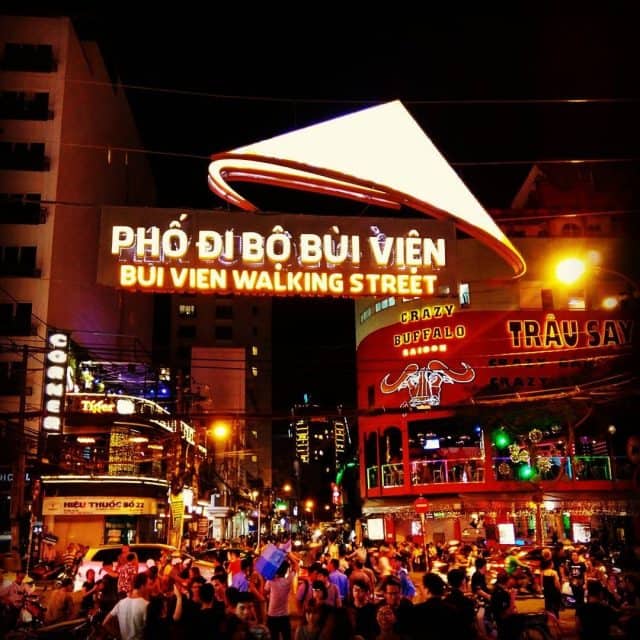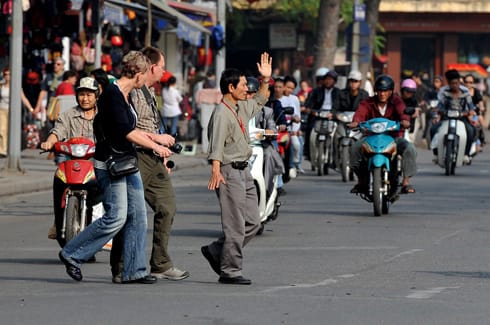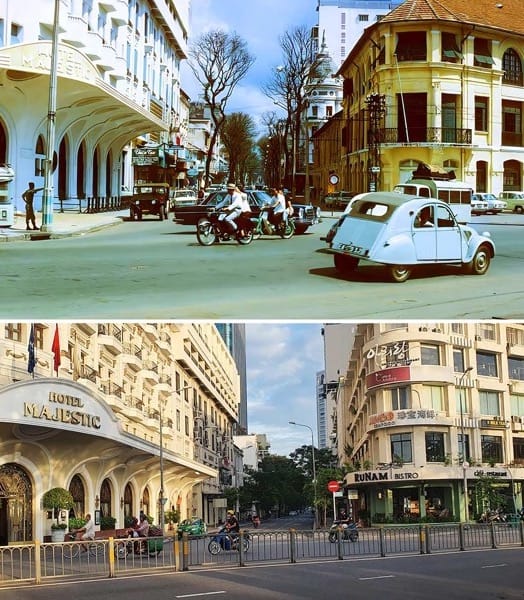Vietnam streets offer a kaleidoscope of experiences for travelers. From bustling food stalls to historic landmarks, each street tells a unique story. Dive into the sensory feast of street food, from pho to banh mi. Wander iconic streets like Bui Vien and Nguyen Hue Walking Street, steeped in history and charm. Learn the art of crossing streets amidst the lively chaos. Discover the heartbeat of Vietnam’s cities in their vibrant streetscapes.
See more: Discover Vibrant Vietnamese Culture on Your Adventure
Contents
Understanding Vietnam’s Street Food Culture
Embark on a culinary adventure through Vietnam’s vibrant street food scene. From bustling markets to charming sidewalk stalls, a world of deliciousness awaits. This guide explores the unique flavors, popular dishes, and affordability of Vietnamese street food, addressing any questions you might have.
A Treasure Trove of Culinary Delights
Vietnamese street food boasts fresh ingredients, bold taste combinations, and a symphony of textures. Whether you wander Hanoi’s captivating Old Quarter or navigate Ho Chi Minh City’s lively streets, tantalizing aromas will guide you to an unforgettable feast.

Must-Try Dishes for Every Palate
- Banh Mi: This delectable fusion features a crispy French baguette overflowing with savory meats, pickled vegetables, fresh cilantro, and a spicy chili sauce, creating a delightful harmony of flavors and textures.
- Bun Cha: Originating in Hanoi, bun cha offers grilled pork alongside vermicelli noodles, fresh herbs, and a delectable dipping sauce. The smoky aroma of the meat complements the tangy sweetness of the sauce for an irresistible combination.
Affordability and Variety
One of the greatest appeals of Vietnamese street food is its budget-friendliness. From humble vendors to bustling night markets, you can enjoy a satisfying meal for just a few dollars. Whether you seek a quick bite or a full-blown culinary exploration, Vietnam’s streets cater to every desire and budget.
The sheer diversity of street food options is staggering. From savory soups and succulent grilled meats to crispy pancakes and refreshing salads, there’s something to tantalize every taste bud. Vegetarian and vegan travelers needn’t worry, as options like banh mi chay and pho chay are widely available.
Prices can vary depending on location, dish type, and vendor. Generally, a simple street food meal can range from $1 to $3 USD. Tourist areas and popular markets may have slightly higher prices.
How to Choose a Safe Vendor?
Opt for stalls with a steady stream of customers and freshly prepared dishes. This helps minimize the risk of foodborne illnesses.
With its vibrant flavors and endless options, Vietnamese street food offers an unforgettable culinary adventure. So, embark on your delicious journey and explore the unique tastes Vietnam has to offer!
Iconic Walking Streets for Tourists in Vietnam
Vietnam’s streets are not merely thoroughfares; they are vibrant arteries pulsating with life, culture, and history. Among the myriad of streets weaving through the country’s bustling cities, several stand out for their iconic status and cultural significance. Let’s take a closer look at two of Vietnam’s most famous streets: Bui Vien in Ho Chi Minh City and Nguyen Hue Walking Street in Saigon.
- Bui Vien Street, Ho Chi Minh City: Known as the backpacker’s hub of Ho Chi Minh City, Bui Vien Street is a bustling thoroughfare lined with hostels, bars, restaurants, and souvenir shops. By day, it offers a glimpse into local life, with vendors selling street food and trinkets. By night, it transforms into a lively entertainment district, pulsating with music, laughter, and the chatter of travelers from around the globe.

Bui Vien Walking Street is One of the Most Famous Vietnam Streets for Tourists – Source: Collected - Nguyen Hue Walking Street, Saigon: Nestled in the heart of Saigon’s downtown area, Nguyen Hue Walking Street is a pedestrian boulevard renowned for its vibrant atmosphere and cultural events. Flanked by colonial-era buildings and modern skyscrapers, this tree-lined promenade is a popular spot for locals and tourists alike to stroll, people-watch, and soak in the city’s dynamic energy. From street performers to art installations, there’s always something happening on Nguyen Hue Walking Street.
The most famous street in Vietnam is a matter of perspective and personal preference. While Bui Vien Street and Nguyen Hue Walking Street are undoubtedly among the most iconic, other streets like Hanoi’s Old Quarter and Hue’s Perfume River promenade also hold significant cultural and historical value.
Characteristics of Vietnam’s streets vary depending on the city and neighborhood. In urban centers like Hanoi and Ho Chi Minh City, streets are often narrow and bustling with motorbikes, bicycles, and pedestrians. They are lined with shops, eateries, and vendors selling everything from fresh produce to souvenirs. In rural areas, streets may be quieter and more laid-back, with fewer vehicles and a slower pace of life.
Crossing Streets in Vietnam
Crossing the streets in Vietnam can be a daunting experience, especially for first-time visitors. The chaotic flow of motorbikes and seemingly never-ending stream of traffic can be overwhelming. However, with a few practical tips and techniques, navigating Vietnam’s bustling streets can become second nature.
Experience of Crossing Streets in Vietnam for First-Time Visitors
For many travelers, the first attempt at crossing a street in Vietnam can be a nerve-wracking experience. The seemingly constant flow of motorbikes, coupled with the lack of designated pedestrian crossings, can leave visitors feeling unsure of how to proceed.
Practical Tips and Techniques for Safely Navigating Vietnam’s Bustling Streets
- One of the most important tips for crossing streets in Vietnam is to remain calm and patient. Instead of waiting for a gap in traffic, start walking at a steady pace while making eye contact with oncoming drivers. This signals your intention to cross, allowing motorists to adjust their speed accordingly.
- Additionally, it’s crucial to avoid sudden movements or darting across the street. Instead, move slowly and predictably, allowing drivers to anticipate your path. When crossing multiple lanes of traffic, aim for small gaps between vehicles and use parked cars or obstacles as refuge points if needed.

It is Difficult to Go Across the Vietnam Streets for First Time – Source: Collected
Addressing Common Concerns and Misconceptions About Crossing Streets in Vietnam
- One common misconception about crossing streets in Vietnam is that you must wait for traffic to stop completely. In reality, traffic rarely comes to a standstill, and attempting to wait for a gap can result in a lengthy delay. By following the flow of traffic and crossing confidently, you can safely navigate the streets with ease.
- Another concern for visitors is the apparent lack of traffic rules. While it may seem chaotic, Vietnam’s streets operate on an unspoken system of give-and-take, with motorists and pedestrians constantly adjusting to each other’s movements.
Exploring the Evolution of Vietnam Streets
Vietnam’s streets have undergone a fascinating evolution, reflecting the country’s rich history and cultural diversity. From ancient pathways to modern thoroughfares, these streets tell stories of innovation, resilience, and adaptation.
Tracing back to ancient times, Vietnam’s streets served as vital trade routes connecting distant regions and fostering cultural exchange. Over centuries, successive dynasties and colonial powers left their mark, influencing architectural styles and urban planning.
Today, Vietnam’s streetscapes exhibit a blend of traditional Vietnamese motifs and colonial-era architecture. From the narrow alleys of Hanoi’s Old Quarter to the wide boulevards of Ho Chi Minh City, each street offers a glimpse into the nation’s past and present.

The role of streets in Vietnamese society is multifaceted. Beyond mere conduits for transportation, they serve as vibrant hubs of activity, where locals gather to socialize, shop, and celebrate. Street vendors ply their trade, offering an array of goods and culinary delights, enriching the sensory tapestry of urban life.
Navigating Vietnam’s streets is made easier by modern advancements, including digital maps and signage. However, the walkability of cities varies, with some areas more pedestrian-friendly than others. Understanding Vietnam’s street map and addressing system can aid travelers in navigating the urban maze efficiently.
Conclusion
In conclusion, Vietnam’s streets weave together the threads of history, culture, and modernity, offering visitors a captivating tapestry of experiences. From the bustling markets to the tranquil alleyways, each street tells a unique story, inviting exploration and discovery. Whether navigating the chaotic intersections or savoring street food delicacies, the streets of Vietnam offer an unforgettable journey through the heart and soul of this enchanting nation.
Frequently Asked Questions
How much is street food in Vietnam?
Street food in Vietnam is incredibly affordable, with prices typically ranging from $1 to $3 USD per dish. However, costs may vary depending on location and the type of dish you choose.
How to cross a street in Vietnam?
Crossing the street in Vietnam can seem daunting at first, but it’s all about confidence and timing. Step out onto the road slowly, making eye contact with drivers, and walk at a steady pace without stopping or running. Vehicles will adjust their speed to accommodate you.
What is the most famous street in Vietnam?
One of the most famous streets in Vietnam is Bui Vien in Ho Chi Minh City. Known for its vibrant nightlife, diverse dining options, and bustling atmosphere, Bui Vien Street is a popular destination for locals and tourists alike.
What are the streets like in Vietnam?
Vietnam’s streets vary widely, from narrow alleyways in historic neighborhoods to wide boulevards in modern cities. They are often bustling with activity, filled with motorbikes, bicycles, street vendors, and pedestrians.
What is the most expensive street in Vietnam?
Nguyen Hue Street in Ho Chi Minh City is considered one of the most expensive streets in Vietnam. Lined with luxury hotels, high-end shopping malls, and upscale restaurants, Nguyen Hue Street exudes sophistication and opulence.
Is Vietnam walkable?
While Vietnam’s cities can be bustling and chaotic, many areas are walkable, especially in the historic districts. Sidewalks may be narrow and crowded, but walking is a great way to explore local neighborhoods and soak in the sights and sounds of Vietnam.


Related Posts
Saigon’s “Flower Market Replica”: Where To Find Them
Ho Chi Minh City’s floral charm is not limited to its bustling wholesale markets. Imagine wandering through a place where vibrant petals, fragrant blooms, and the spirit of traditional Vietnamese markets come alive—without the overwhelming crowds. A flower market replica captures that magic, blending the beauty of fresh flowers with the charm of a curated, […]
Is it Safe to Travel to Vietnam Right Now? A Complete 2025 Guide
Vietnam has emerged as one of Southeast Asia’s most captivating destinations, drawing millions of visitors annually with its rich culture, stunning landscapes, and incredible cuisine. However, many travelers still ask: Is it safe to travel to Vietnam right now? This comprehensive guide provides you with everything you need to know about Vietnam travel safety in […]
Ho Chi Minh Cu Chi Tunnels Tour: The Ultimate Guide
The Cu Chi Tunnels stand as one of Vietnam’s most remarkable historical sites, offering visitors a profound glimpse into the ingenuity and resilience displayed during the Vietnam War. For travelers, a Ho Chi Minh Cu Chi tunnels tour represents an essential experience that combines education, adventure, and deep cultural understanding. This comprehensive guide will help […]